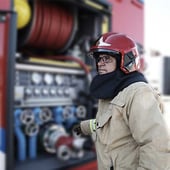You’d be surprised to learn just how many fire stations launder their fire suits in-house. It might seem harmless, but laundering your suits without proper protocols can do more than just jeopardise their structural integrity. Firefighter suits are complex personal protective equipment (PPE) garments with multiple components requiring customised care. So why is it that so many fire stations take the considerable risk of in-house washing and drying? And how can you make sure that your gear gets the best care possible? In this blog, we explain why outsourcing to a professional launderer can be a safer and smarter choice for modern fire brigades.
Trends in washing, drying, and maintenance
There’s a historical explanation for why many fire brigades unwittingly do their own laundering. In the past, a dirty fire suit was worn proudly and perceived positively as a symbol of heroism — it showed that the firefighter in question had actually been in action. Fire suits were made to withstand around 25 washing cycles. Little wonder fire brigades didn’t wash their clothing very often, and when they did, they did it in-house and mostly without proper protocols.
These days, with rising awareness about particle contamination hazards, fire suits are washed more frequently. Many fire brigades still launder their PPE in the same in-house washing machines and dryers they use to wash station wear, with potentially disastrous consequences. Here are three reasons why a partnership with an external professional laundry or service provider is favorable for modern fire brigades.
1. Less damage, maintaining protection
Firefighter suits are very complex PPE garments. Within the carefully designed assembly in a suit are multiple components requiring special treatment. Washing or drying the suit incorrectly can damage these components and destroy their protective attributes.
It’s a matter of following protocols. This relates not only to washing and drying, but also to inspecting and checking the integrity of the garment. Once garments are washed and dried, there should be a final inspection of all layers to ensure the assembly retains its functional integrity. This means in many cases turning all layers completely inside out in order to inspect them and carry out proper maintenance and repairs.
If damage to the suit’s inner layers is not seen and repaired, firefighters will operate under the assumption that they’re fully protected until a worst case scenario proves otherwise — and they find themselves wearing damaged garments which don’t protect them properly.
Industrial laundries and other service providers are aware of the proper protocols to prevent these breaches in protection. Furthermore, they have many resources and equipment to repair garments, as well as the access to all components and accessories that might be needed.

2. Better return on investment
PPE is a valuable investment, and laundering your suits improperly is a surefire way to penalize your return on that investment. In-house washing might seem the cheaper solution for a fire brigade, but if done incorrectly, the fire suits are damaged long before expected EOL (end-of-life), your station will have to buy new suits much sooner.
When it comes to repairs and maintenance, it’s a similar story. Repairing damaged garments correctly can increase the garments’ lifespan, and thus protect your return on investment (ROI). Professional service providers usually have better resources to repair damaged garments than in-house laundries do.
In the past, fire suits were made out of lesser materials which could only withstand 25 washing cycles. New fire suits are much more durable these days, but some fire brigades still stick to the principle of replacing their suits after 25 washing cycles — which in some cases could mean replacing them almost every year. A laundering protocol can help extend a garment’s EOL far past these 25 cycles (if proper traceability and assessment is established), thus increasing your ROI.
3. Documentation and liability
Not only do professional service providers offer protocols for launderings, inspections, and repairs, they also document a garment’s life cycle thoroughly. Insights into how often a fire suit has been laundered, which repairs have been performed, and which temperature or chemicals to which it was exposed are important in the event of an incident. Liability is a very thin line, but professionalization can make it thicker.
If the incident is the result of ineffective or non-operational PPE, the fire brigade might be held responsible. Proper documentation allows a stronger case to be made for insurance. Without it, it’s extremely difficult to prove whether something was done to the suits to impact their integrity. A well-referenced, traceable process is not just crucial to proving that garments are maintained properly, but it offers fire brigades the reassurance of protection, as well.
Protect your firefighters properly
In short, there are many reasons why it’s beneficial to outsource the laundering and maintenance of fire suits. Fire suits must be properly laundered and maintained in order to do what they are designed for: protecting your firefighters properly. It will also extend the garment’s life cycle, ensure a higher ROI, and ensure proper protocol documentation in case of an incident. Would you like to learn more about proper protocols, service providers or other ways you can keep your PPE garments in fighting shape? Please feel free to contact us. Our Fire Service specialists would be happy to help you.






.png?width=399&name=Untitled%20design%20(50).png)

